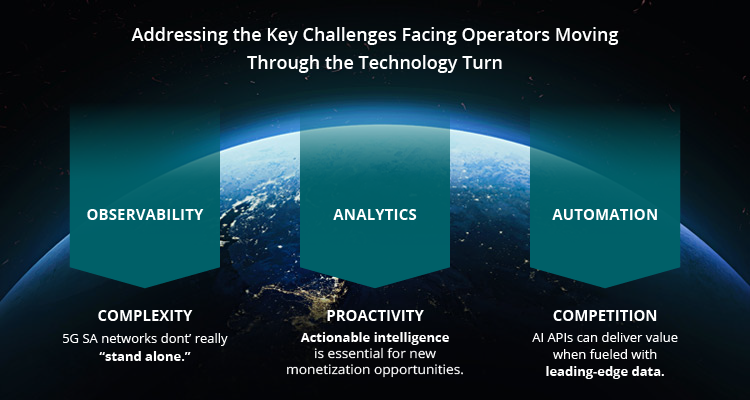5G Reality Check: Standalone Is Not Really Standalone
Observability is key to achieving critical monetization goals.

5G standalone (SA) deployments are on the rise. According to a recent report by Market.us Media, growth in the global 5G SA network market is estimated to reach a compound annual growth rate (CAGR) of 51.6 percent by 2033. With the massive increase in 5G SA investments, communications service providers (CSPs) will face a critical challenge in monetizing the network for consumers and enterprises alike. Under pressure to guarantee low latency, deliver bandwidth efficiency, and assure unparalleled reliability, these operators will need a solution that can tackle the complexity of a multigeneration network.
5G Standalone Is Not Actually a Standalone Network
The term 5G SA is a bit deceiving. Despite its name, 5G SA is not actually a standalone network. 5G SA works in parallel with previous technologies and features a 5G core composed of dual-stack 4G and 5G cloud-native nodes. Although any 5G SA device may operate as 5G, it is also attached to 4G, with a single dual-mode core managing both the 4G and 5G signaling.
In this model, the 5G session-management function (SMF), a critical component in the 5G core network, also acts as a packet data network gateway (PGW) or Serving Gateway Control (SGW-C) from an Evolved Packet Core/Long-Term Evolution (EPC)/LTE) point of view. Here, the node handles the session/IP addresses for a given device across the various access technologies. The same dual-stack nature applies to several other nodes, including the access and mobility management function/Mobility Management Entity (AMF/MME) and the user plane function/packet data network switch gateway user plane (UPF/PSGW-u).
The resulting complexity of a single cloud-native core that manages services (e.g., voice with its multiple variants—Voice over New Radio and Evolved Packet System fallback) across parallel radio access technologies (RATs) brings about new requirements and presents an observability challenge.

The Importance of Observability in the Face of Complexity
The complexity of 5G SA cloud-native networks makes it difficult to gain the visibility needed to assure performance, but it also magnifies the importance of doing just that. Service providers need to clearly delineate metadata on a per-location and per-RAT basis to figure out what is really going on.
East-west traffic visibility inside the 4G/5G cloud-native core is crucial, particularly in the face of cloud-native microservice architectures using Kubernetes, the de facto standard platform for orchestrating containers. In this environment, east-west visibility is critical at all layers in the stack.
Whenever the mixture of legacy mobile core and cloud-native is used, end-through-end visibility—or what NETCOUT calls Visibility Without Borders—must be achieved with a single unified data set and a common user interface across all technologies. NETSCOUT’s partnership with Swisscom and Ericsson is one example of successfully providing such visibility inside and outside a cloud-native core. Announced in October 2022, the world’s first solution enabling 5G packet data processing in the cloud was able to address key industry challenges by providing the following:
- End-through-end visibility from packets all the way up to rich metadata in 5G cloud-native networks
- Effective handling of cloudification and encryption
As CSPs move to 5G cloud environments, end-through-end observability is increasingly important for providing continuous real-time data to support the shift toward zero-touch autonomous networks—and more importantly, to open the door to new revenue opportunities.
NETSCOUT is uniquely qualified to provide 5G SA assurance and analytics. We have developed scalable deep packet inspection (DPI) technology that isolates “signal from noise” at the source, across core and RAN. We provide near real-time data 24/7. NETSCOUT is committed to helping the industry in its shift to automation on the path to further monetization.
Explore the difference between 5G SA and 5G NSA.
Learn more about the NETSCOUT solution.